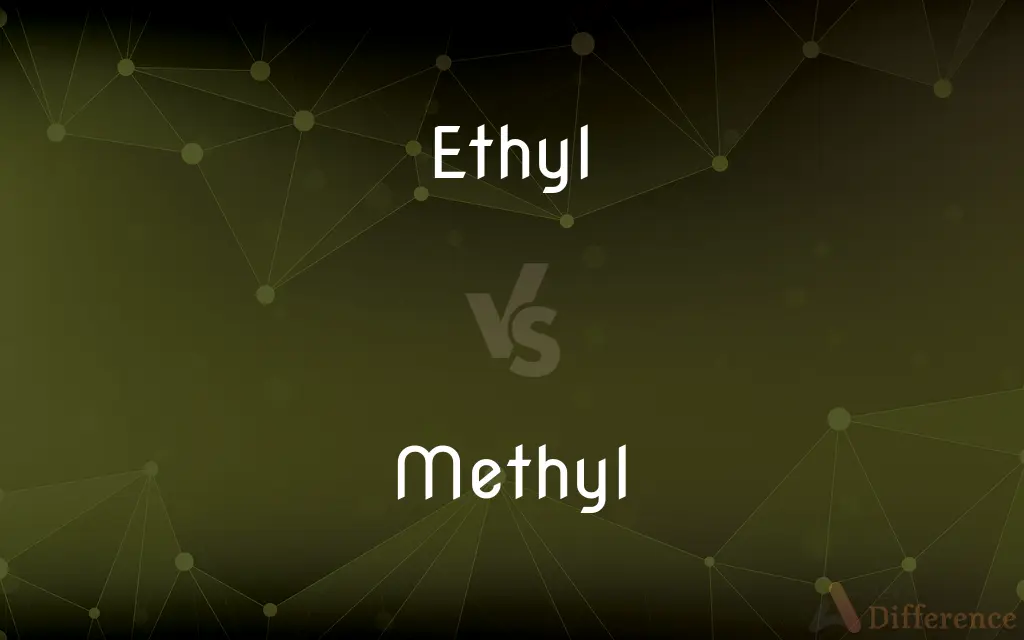Ethyl vs. Methyl — What's the Difference?
By Fiza Rafique & Maham Liaqat — Updated on April 18, 2024
Ethyl and methyl groups are both alkyl substituents derived from alkanes, with ethyl containing two carbon atoms, while methyl has just one.

Difference Between Ethyl and Methyl
Table of Contents
ADVERTISEMENT
Key Differences
An ethyl group consists of two carbon atoms (-CH2CH3), making it a larger structure compared to a methyl group, which contains only one carbon atom (-CH3). This size difference affects their physical properties and reactivity in organic compounds.
While the ethyl group provides a slightly higher molecular weight to compounds, the methyl group, being smaller, typically results in lower molecular weights. This impacts the boiling and melting points of compounds they are part of.
In terms of reactivity, ethyl groups, due to their larger size, can influence the steric hindrance in chemical reactions more than methyl groups. This steric effect can affect reaction rates and product formation.
On the other hand, methyl groups are often used in chemistry to increase the electron density of molecules through hyperconjugation, enhancing their reactivity in certain types of reactions.
Ethyl groups can also confer different solubility characteristics to molecules compared to methyl groups, due to their larger size and different interaction dynamics with solvents.
ADVERTISEMENT
Comparison Chart
Carbon Atoms
2
1
Molecular Weight
Higher
Lower
Steric Hindrance
More pronounced
Less pronounced
Reactivity
Alters with larger size
Enhanced by hyperconjugation
Solubility
Influenced by larger size
Less influenced by size
Compare with Definitions
Ethyl
Alters solubility characteristics of compounds.
Ethyl cellulose is used in pharmaceutical formulations.
Methyl
A hydrocarbon group derived from methane.
Methyl alcohol (methanol) is used as a solvent and antifreeze.
Ethyl
Contains two carbon atoms linked to hydrogen atoms.
Ethyl acetate is used as a solvent in nail polish removers.
Methyl
Commonly found in organic molecules.
Methyl red is an indicator in pH testing.
Ethyl
Often used in organic chemistry as a substituent.
Ethyl bromide is a reagent in organic synthesis.
Methyl
Contains one carbon atom bonded to three hydrogen atoms.
Methyl chloride is utilized in the production of silicones.
Ethyl
A hydrocarbon group derived from ethane.
Ethyl alcohol (ethanol) is commonly used in beverages.
Methyl
Can affect the melting point of substances.
Methylated spirits are used as a cleaning agent.
Ethyl
Can increase the boiling point of molecules.
Ethyl chloride is a gas used as a local anesthetic.
Methyl
Increases the electron density of molecules.
Methyl groups in toluene enhance its reactivity.
Ethyl
Relating to or being a hydrocarbon unit, C2H5, that can occur as a substituent in an organic compound or as an ion or radical.
Methyl
Relating to or being the simplest hydrocarbon unit, CH3, that can occur as a substituent in an organic compound or as an ion or radical.
Ethyl
(organic chemistry) The univalent hydrocarbon radical, C2H5, formally derived from ethane by the loss of a hydrogen atom.
Methyl
(organic compound) The univalent hydrocarbon radical, CH3-, formally derived from methane by the loss of a hydrogen atom; a compound or part of a compound formed by the attachment of such a radical.
Ethyl
A monatomic, hydrocarbon radical, C2H5 of the paraffin series, forming the essential radical of ethane, and of common alcohol and ether.
Methyl
A univalent hydrocarbon radical, CH3-, not existing alone but regarded as an essential residue of methane, and appearing as a component part of many derivatives; as, methyl alcohol, methyl ether, methyl amine, etc.
Ethyl
The univalent hydrocarbon radical C2H5 derived from ethane by the removal of one hydrogen atom
Methyl
The univalent radical CH3- derived from methane
Common Curiosities
What is an ethyl group?
An ethyl group is a two-carbon alkyl substituent derived from ethane.
What is a methyl group?
A methyl group is a one-carbon alkyl substituent derived from methane.
What is the effect of methyl groups on reactivity?
Methyl groups can enhance the reactivity of molecules through hyperconjugation.
Can ethyl and methyl groups influence the boiling point of a compound?
Yes, ethyl groups generally increase boiling points more significantly than methyl groups.
Can both ethyl and methyl groups be functionalized?
Yes, both groups can be modified in chemical reactions to create various derivatives.
How do ethyl and methyl groups affect molecular weight?
Ethyl groups increase molecular weight more than methyl groups due to having more carbon atoms.
What role do ethyl groups play in steric hindrance?
Ethyl groups create more steric hindrance in reactions compared to methyl groups.
Are ethyl and methyl groups found naturally?
Both groups are commonly found in natural and synthetic organic compounds.
Why are methyl groups important in organic synthesis?
Methyl groups are crucial for increasing electron density and affecting reaction pathways.
How do ethyl groups influence solubility?
Ethyl groups can enhance solubility in organic solvents due to their larger size.
Share Your Discovery

Previous Comparison
Godchild vs. Goddaughter
Next Comparison
Texture vs. PatternAuthor Spotlight
Written by
Fiza RafiqueFiza Rafique is a skilled content writer at AskDifference.com, where she meticulously refines and enhances written pieces. Drawing from her vast editorial expertise, Fiza ensures clarity, accuracy, and precision in every article. Passionate about language, she continually seeks to elevate the quality of content for readers worldwide.
Co-written by
Maham Liaqat













































